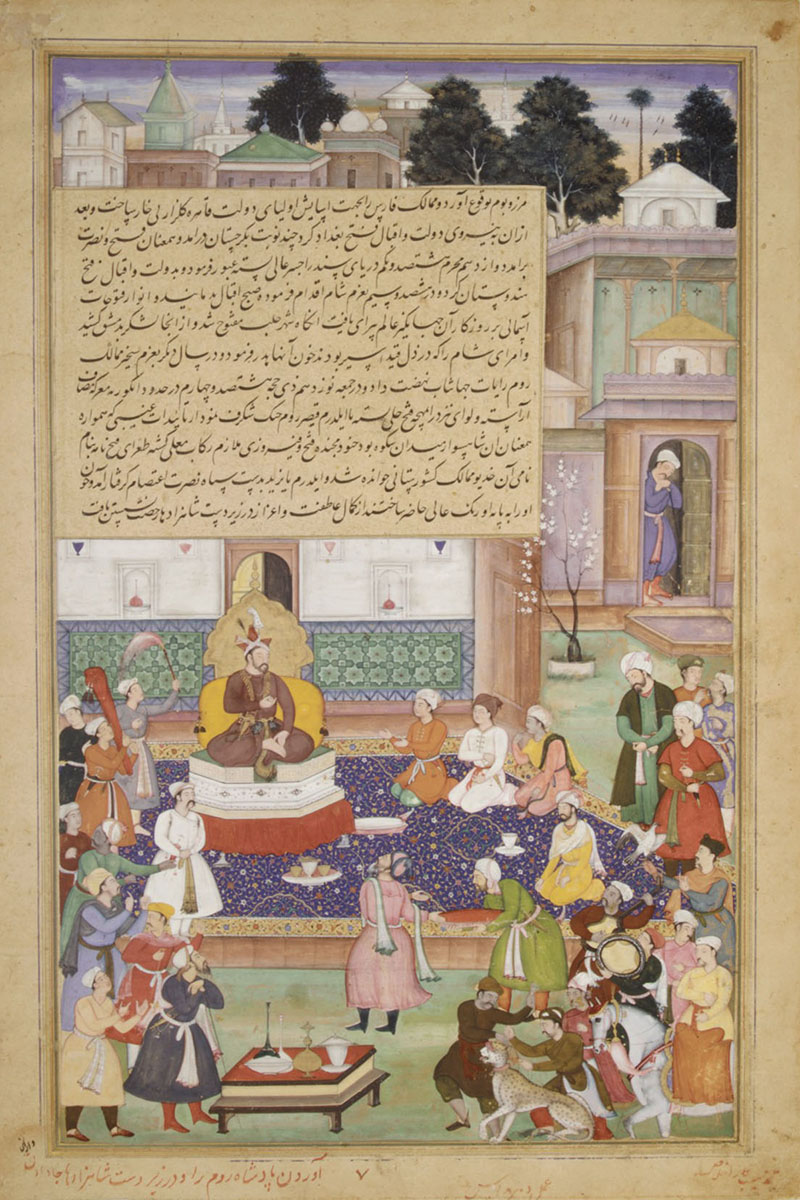An official chronicle of the reign of Akbar, the Akbarnama is a collection of texts and illustrated manuscripts, written in Farsi (Persian) by the court historian and biographer Abu’l-Fazl ibn Mubarak, and commissioned by Akbar himself. Composed between 1590 and 1597 CE, the manuscript consists of 274 folios of text interspersed with 116 illustrated folios and one illuminated frontispiece. The manuscript was worked on by some of the most celebrated painters of the time such as Basawan, Miskin, Farrukh Beg, Lal, Kesar Kalan, Jagan, Mukund and Madhu, amongst others.
Each folio is sized at 38.1 x 22.4 cm, with the paintings averaging about 33 x 20 cm. As its author, Abu’l-Fazl is likely to have written the entire manuscript and then commissioned artists from Akbar’s atelier to illustrate parts of the script. The entire manuscript is divided into three volumes with volumes I and II dedicated to Akbar’s childhood and a detailed history of his reign till 1602. Volume III, also known as Ain-i-Akbari, documents matters of administration and the culture within Akbar’s regime. The text is arranged in twenty lines of text per page, written in nastaliq script. The margins of each folio carry the names of different artists — written in nastaliq script with red ink — involved in the composition, colouring and finishing of each painting. The margins also consist of the folio numbers that may indicate that the original manuscript may have had close to 200 paintings. In some cases the paintings span over an entire spread and depict elaborate scenes such as sieges or hunts, culminating in a total of twenty-eight double-page paintings in the entire manuscript.
The Akbarnama is both a unique and representative document of its time. Unique because, unlike other historical records such as the Baburnama or Tarikh-i-Khandan-i-Timuriya, the Akbarnama was created during the lifetime of Akbar, allowing the creators of this manuscript to be eye-witnesses to his life. In the traditional style of Mughal miniature painting, there was a great collaboration between the artists for the creation of each painting. It was first composed by a master painter (tarah), followed by the colouring which would be done by one of the junior artists or assistants (amal or rang amizi), and occasionally a third artist was assigned to paint the faces (chehra nami). Thus most paintings in the manuscript are collaborations between different artists except for eleven which are the work of single artists.
Some of the most notable painters of the manuscript include Farrukh Beg, known for his decorative use of landscape and architecture, Miskin for his studies of animal and human figures, Basawan, for his attention to human characterisation and Kesu, known for his portraits. Amongst them, Lal is credited with having painted the maximum number of paintings in the manuscript. Other artists such as Mansur worked as colouring artists or assistants on this manuscript.
The most complete version of the manuscript with 116 paintings was bought by the South Kensington Museum in 1896 from Mrs Frances Clarke; her husband had acquired the manuscript upon his retirement from serving as Commissioner of Oudh (1858–1862). This version of the Akbarnama is now housed at the Victoria and Albert Museum (V&A), London.







